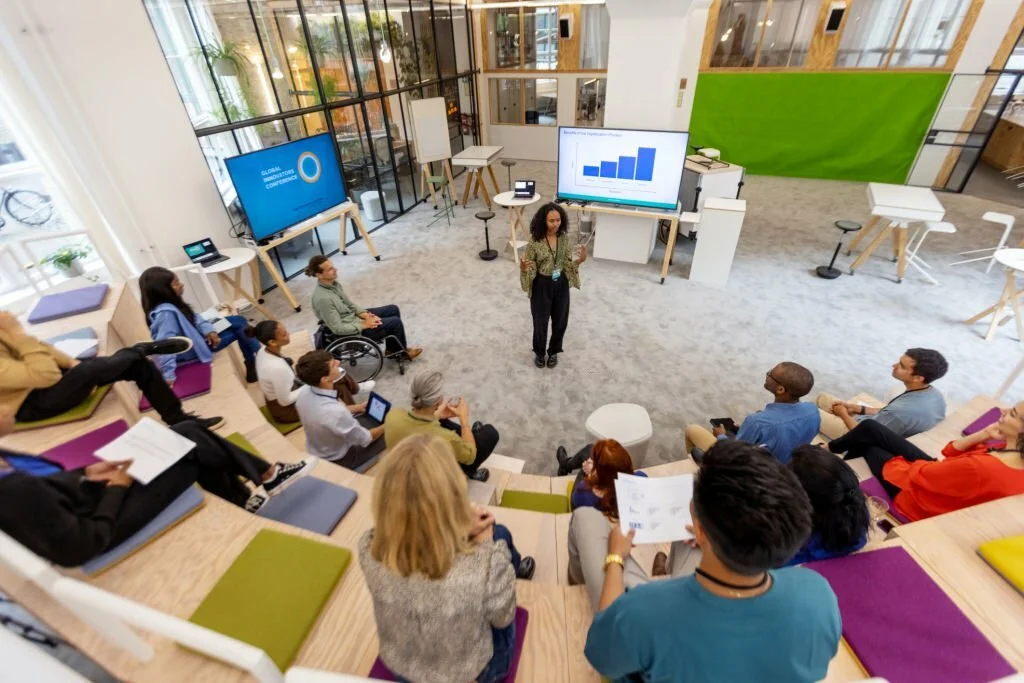Many people talk about creating a learning culture. A learning culture is important because it can help unlock the full potential of employees and thus drive the company forward. “The biggest driver for achieving business goals depends on the strength of an organization’s learning culture,” says Josh Bersin in the High-Impact Learning Culture report.
But what exactly is a learning culture? I would like to rely on two different definitions from CEB & ATD* which I summarize and translate freely.
A learning culture supports employees’ autonomy, curiosity and willingness to constantly seek, learn, grow, perform and share new knowledge that contributes to improving individual and organizational performance towards the company’s business goals.
By now, I have been on a lot of assignments with clients where I have helped identify and visualize strategic frameworks to start the journey to a learning culture. Like many other times when it comes to culture, it can be difficult to move from talking about it to getting all stakeholders and employees on board, to start doing and making it happen. A survey shows that 98% say organizations want to develop a learning culture, but only 36% say they have succeeded (CIPD 2020). And it IS complex and big to land what a learning culture really means and how it should work, especially if you are a larger company where many people are involved. It can also mean different things to different companies and organizations.
But how do you start untangling all the threads and begin the journey to a learning culture? I think it’s good that you start by sketching a dream picture based on three simple overarching questions:
- WHAT is and means a learning culture in our company?
- HOW should I as an employee experience culture and learning?
- WHERE (in which channels and arenas, physically/digitally, individually/with others) can I as an employee learn and “live” the learning culture?
3 tools to start from There are a couple of tools that I think work very well to start mapping an organization’s existing learning and current situation. You can then use these to start identifying and concretizing some of the changes you need to start to make your dream come true. It won’t solve everything, of course, but it’s a good start to get going.
1. Employee experience
Bring together internal stakeholders in learning and development, culture, values and employee experience. Map the employee’s journey from start to continuous learning and reflect openly together. How is the journey connected? What happens on the road? Where is the employee at different stages? What arenas for learning exist today? Who is responsible for what? How do we support the employee along the way? This gives you a good initial picture to work on. Reflect on what you need to improve, what to keep or remove. Include multiple perspectives – experience, technology, goals, support and content. How can you work together to create a common thread and a good employee experience throughout?
2. Learning ecosystems
A learning ecosystem is a kind of holistic and strategic framework for all learning that takes place within an organization. You can either just start from WHERE you learn or use the model to discuss WHERE/HOW/WHAT you learn. There are several variants, theories and approaches to learning ecosystems, such as Jane Hart* and others focus mostly on tools. I like to think a bit further and often use the three-step model.
- First, define the different channels and arenas in which you learn today, such as ex. digitally, physically or at work.
- Then add more channels and venues you need to add to reach your dream image.
- The next step is to identify what and how – but also what you need to do to fill the channels and arenas with knowledge. For example, if you ex. has Office Teams/SharePoint as a channel – how will you work with learning there? What methods should you use? What is the plan for content curation?
3. Culture to behavior
Start with your definition of what a learning culture is for you and break it down into concrete behaviors you want all employees to adopt. Behaviors often associated with learning culture include psychological safety, daily learning, sharing experiences and openness, etc. fl. Start concretizing how you can support these behaviours throughout the employee journey to make them happen. Also consider what tools you can give your leaders to enable desired behaviors and explore what processes, structures and everyday activities you can support to create opportunities for learning.
Of course, it is also important to align the learning culture with the company’s business objectives from the outset. Ensure that communication, content and knowledge in particular are aligned with the current business plan, strategy and values. Then, of course, you should also gather experiences from all parts and levels of the organization, stakeholders, leaders and target groups – the more you have on your feet before you start drawing the dream picture and map of your learning culture, the better the results will be.
Sources and other interesting links:
CEB (The Centre for Economics & Business research): https://cebr.com/
ATD (Association of Talent Development) https://www.td.org/education-courses/learning-culture
Jane Hart Ecosystem: https://www.modernworkplacelearning.com/cild/5-tools-for-workplace-learning/
Josh Bersin & Associates research report, High-Impact Learning Culture: The 40 Best Practices for Creating an Empowered Enterprise: https://action.deloitte.com/insight/1392/key-takeaways-from-our-high-impact-workforce-research
CIPD Report: https://www.cipd.co.uk/Images/creating-learning-cultures-1_tcm18-75606.pdf
ELUCIDAT: https://www.elucidat.com/blog/5-ways-to-create-a-learning-culture-in-your-organization/
Written by Tereza Kennedy Olsen CEO, Creative Director & Founder, Atom Collaboration




